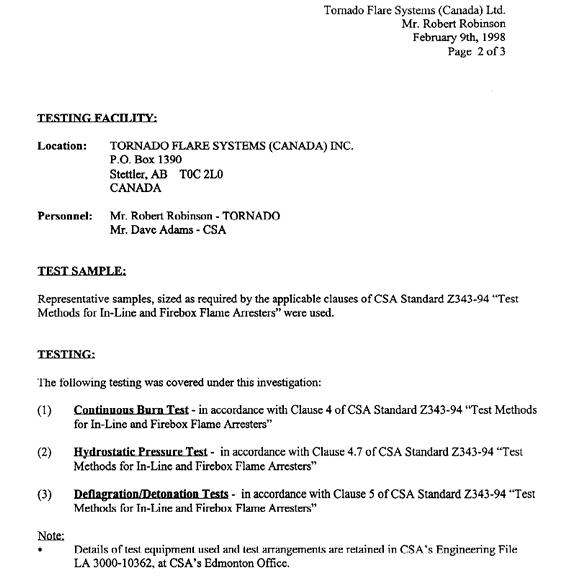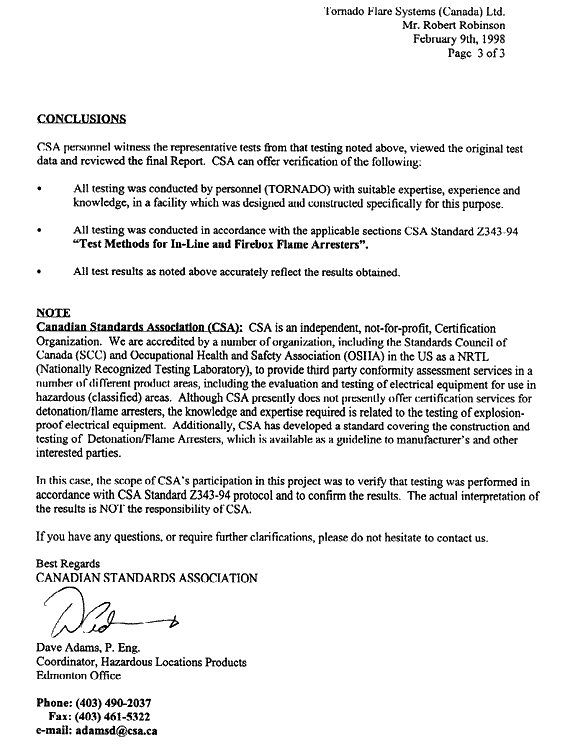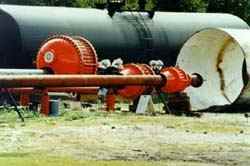|
 |
 |
|
 |
 |
TEST METHODS FOR
|
Test Methods
for In-Line and Firebox Flame Arrestors
CSA Z-343
Second Edition

1. SCOPE
1.1
This Standard describes test methods for use in assessing the performance of flame
arrestors intended for use with Class I, Group C and D flammable gases and vapors as
defined in CSA Standard C22.1 - Canadian Electrical Code in applications such as flare
stacks, firebox air intakes, and vent lines. This Standard does not apply to the details
of construction, specification, selection, application, maintenance, or any of the other
factors which must be considered for a suitable flame arrestor installation.
| Note 1: | See Appendix A for general background information concerning flame arrestors and test procedures. |
| Note 2: | A vertical line in the left column of this draft document indicates that a change has occurred in this clause, relative to the First Edition of this Standard. |
| Note 3: | Italicized text indicates that there is a definition for that term in the Definitions section of this Standard. Since the defined terms "flame arrestor", "firebox", and ''in-line" are used extensively, they are not italicized. |
1.2
Standard applies to flame arrestor installations where the ambient temperature to which
the arrestor is exposed is in the range -45°C to 100°C, and where the maximum operating
pressure for flame arrestment is 108.25 kPa (absolute), unless otherwise stated by the
manufacturer (see clause 1.4). This standard covers the testing of complete flame arrestor
units only, (consisting, as a minimum, of a flame arrestor housing and flame arrestor
element), and does not apply to the testing of individual components thereof. Performance
tests of a flame suppression system, which may form part of a flame arrestor assembly, are
not within the scope of this standard. A flame warning system is mandatory for any in-line
flame arrestor being tested to this standard.
| Note 1: | The above temperature range is intended to represent normal outdoor seasonal temperature and pressure extremes to which a flame arrestor may be exposed in normal use. |
| Note 2: | A device tested to this Standard may be operated at higher pressures, but flame arresting capabilities at pressures above 108.25 kPa (absolute) within the scope of this Standard, unless performance claims in this regard are stated by the manufacturer (see clause 1.4). Internal operating pressures would normally be expected to be lower than 108.25 kPa (absolute) where a low flow or loss of flow condition exists - the condition of most concern. |
| Note 3: | If a flame suppression system is included with an in-line flame arrestor to enhance the overall performance of the system, the intent of this standard is to assess the performance of the in-line flame arrestor element only. Accordingly, this may require that a flame suppression system which is supplied with an in-line flame arrestor be disabled for certain tests in this Standard. |
1.3
This standard does not apply to the following:
| a) | flame arrestors intended for installations in, on, or associated with explosion proof electrical enclosures as defined in CSA Standard C22.2 No. 30; |
| Note: | Requirements for flame arrestors installed on explosion proof enclosures are stated in CSA Standard C22.2 No. 30. |
| b) | flame arrestors used for intake and exhaust system explosion protection of diesel engines; |
| c) | flame arrestor systems using other than porous media flame arrestor elements. These may be employed at the user's discretion, but not within the scope of this Standard; |
| Note: | The intent of this clause is to limit the scope of this standard to cover only flame arrestors that use porous media to provide flame-arresting capability.The tests in this standard are designed to asses porous media-type flame arrestors only; application of these tests to other flame arresting technologies that do not use porous media may not be appropriate. |
| d) | flame arrestors for use in oxygen enriched atmospheres; |
1.4
The test requirements of this standard are minimum performance requirements. Performance
claims specified by the manufacturer, such as may be made concerning flame arrestor
operating pressure, which exceed these minimum stated performance requirements shall be
verified in accordance with the procedures of this Standard,
2. REFERENCE PUBLICATIONS
All references shall be considered to refer to the latest edition and revision thereto,
unless otherwise specified. This Standard refers to the the following Standards and the
year dates shown indicate the latest editions available at the time of printing:
| CSA
Standards C22.1-1986 |
Canadian
Electrical Code Part 1; |
| C22.2 No. 30-M1986 | Explosion-proof Enclosures for use in Class 1 Hazardous Locations |
| Other useful references include: | |
| Underwriters'
Laboratories Standards UL 525 |
Flame arrestors for use on Vents of Storage Tanks for Petroleum Oil and Gasoline Published by Underwriters' Laboratories Inc. |
| MSC/Circ. 373/Rev.1 | International Maritime Organization, Maritime Safety Committee Circular No. 373, Revision No, 1. |
| Federal
Register Vol. 55, No. 120 June 21, 1990 Appendix A to Pad 154 |
Guidelines for Detonation Flame arrestors |
| API RP12N | Recommended Practice for Operation, Maintenance, and Testing of Firebox Flame arrestors |